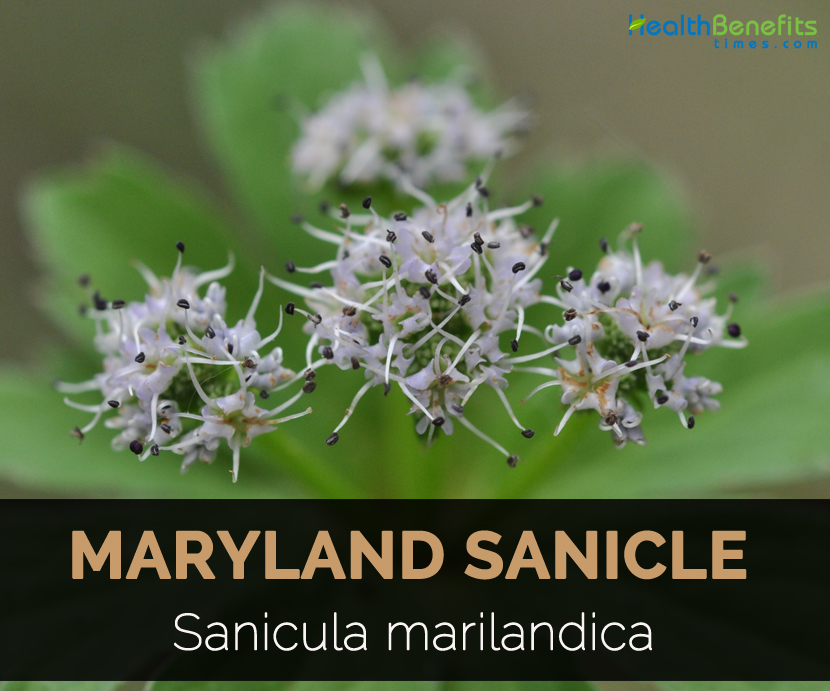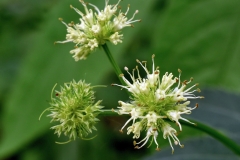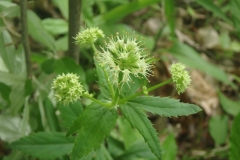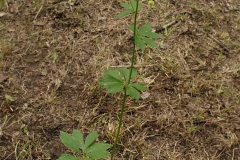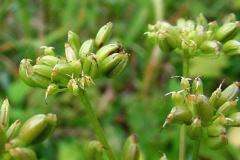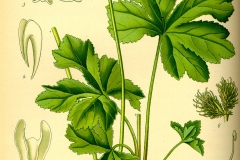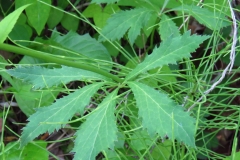| Maryland Sanicle Quick Facts | |
|---|---|
| Name: | Maryland Sanicle |
| Scientific Name: | Sanicula marilandica |
| Shapes | Oval, dry, with hooked, stout |
| Name | Maryland Sanicle |
|---|---|
| Scientific Name | Sanicula marilandica |
| Common/English Name | Black Snakeroot, American Sanicle, Pool Root, Wood Sanicle, Maryland sanicle, Maryland black snakeroot, Black sanicle, Butterwort |
| Name in Other Languages | English: Maryland sanicle, Black snakeroot, Maryland black-snakeroot;
French: Sanicle du Maryland |
| Plant Growth Habit | Plant Growth Habit |
| Plant Growth Habit | 7.5 dm (29 in.) |
| Stem | Solitary, erect 4-12 dm tall |
| Medicinal parts | The root and leaves |
| Flowering Season | June to mid August |
| Flower | Ovoid schizocarp, 4-6 × 3-5 mm, compressed |
| Fruit shape & size | Oval, dry, with hooked, stout |
Leaves and stems
Leaves are basal and alternate on the stem, palmately compound having 5 or 7 leaflets or 5 leaflets with end pair deeply cleft. Leaflets measures 6 inches long to 2 inches wide, coarsely toothed or double toothed, hairless and wedge shaped at the base and usually widest above the middle. Basal and lower stem leaves are long stalked, stalkless or nearly so in the upper plant. Stems are hairless, erect and branched in the upper plant.
Fruit
Fruit is dry, round to somewhat oval about 1/6 inch long covered in hooked bristles. Long arching style remains at the tip. The fruit is dry, round to somewhat oval, about 1/6 inch long and covered in hooked bristles. The long arching style remains at the tip. The fruit splits into 2 seeds.
Medicinal uses
- Used by the Indians in intermittent fevers and for treating a variety of skin conditions.
- The action upon the system very much resembles Valerian, possessing (besides the previously mentioned) nervine and anodyne properties.
- It possesses powerful cleansing and healing virtues, both internally and externally.
- It heals, stops bleeding, diminishes tumours, whether of a recent or long-standing nature.
- The properties when administered seem to seek the ailment most in distress, be it of the throat, lungs, intestines or renal tract, reproductive organs.
- Its qualifications are many as a cleansing and healing herb, both of man or animal.
- For throat discomforts, gargle a strong tea with honey as often as necessary.
- The fresh juice can be given in tablespoonful doses in treatment of dysentery, and strong decoction of the leaves made by boiling 1 oz. of the leaves in 1½ pints of water, reduced to 1 pint, can be taken constantly in wineglass doses till haemorrhage ceases.
- Root acts as expectorant, nervine and astringent.
- Tea made from thick root is used for treating menstrual irregularities, kidney ailments, pain, fevers and rheumatism.
- Root decoction is used to cause vomiting to neutralize poison.
- Root powder is also used for treating intermittent fever and chorea.
- Apply the poultice made from roots for snakebites.
Dose
1 teaspoonful of the root or leaves, cut small or crushed, to 1 cupful of boiling water. Take 1 cupful ½ hr. before meals. If haemorrhaging, it is best to refrain from food until bleeding stops. Of the tincture, I5–30 drops. Of the powder, 1 dram.
Externally
For cutaneous or subcutaneous skin conditions, chapped hands or bleeding skin ulcerations use a fresh preparation daily for chronic conditions until they improve. Internally and externally, can be combined with other supporting herbs.
Homoeopathic Clinical
Amenorrhoea, Asthma, Bee stings, Boils (blind), Borborygmus, Coccyx (soreness of), Condylomata, Conjunctivitis, Constipation (of children), Cornea (ulceration of), Coryza, Cough, Dandruff, Debility, Diabetes, Diarrhoea, Digestion (slow), Dropsy (during pregnancy), Eczema, Emaciation, Enuresis, Excoriations, Foot sweat, Gastritis, Gum (suppressed), Itching, Leucorrhoea, Liver (soreness of), Lumbago, Melancholy, Milk (thin), Mouth (sore), Neuralgia, Neurasthenia, Night terrors, Nose (crusts in), Ophthalmia (tarsi), Os utteri (dilated), Ossification (too early), Ozaena, Perspiration (excessive), Potbellied children, Pregnancy (sickness af; dropsy of), Rectum (cramp in), Rheumatism, Rickets, Scurvy, Sea sickness, Shoulders (rheumatism of), Throat (sore), Tongue (ringworm of; burning), Toothache, Uterus (prolapse of; soreness of; tumour of), Vomiting (of milk; of water), Wrist (boils on).
References:
https://www.itis.gov/servlet/SingleRpt/SingleRpt?search_topic=TSN&search_value=29856#null
https://pfaf.org/user/Plant.aspx?LatinName=Sanicula+marilandica
https://www.dnr.wa.gov/publications/amp_nh_sama2.pdf
https://en.wikipedia.org/wiki/Sanicula_marilandica
https://www.minnesotawildflowers.info/flower/maryland-black-snakeroot
https://plants.usda.gov/core/profile?symbol=SAMA2
http://wisflora.herbarium.wisc.edu/taxa/index.php?taxon=4975


